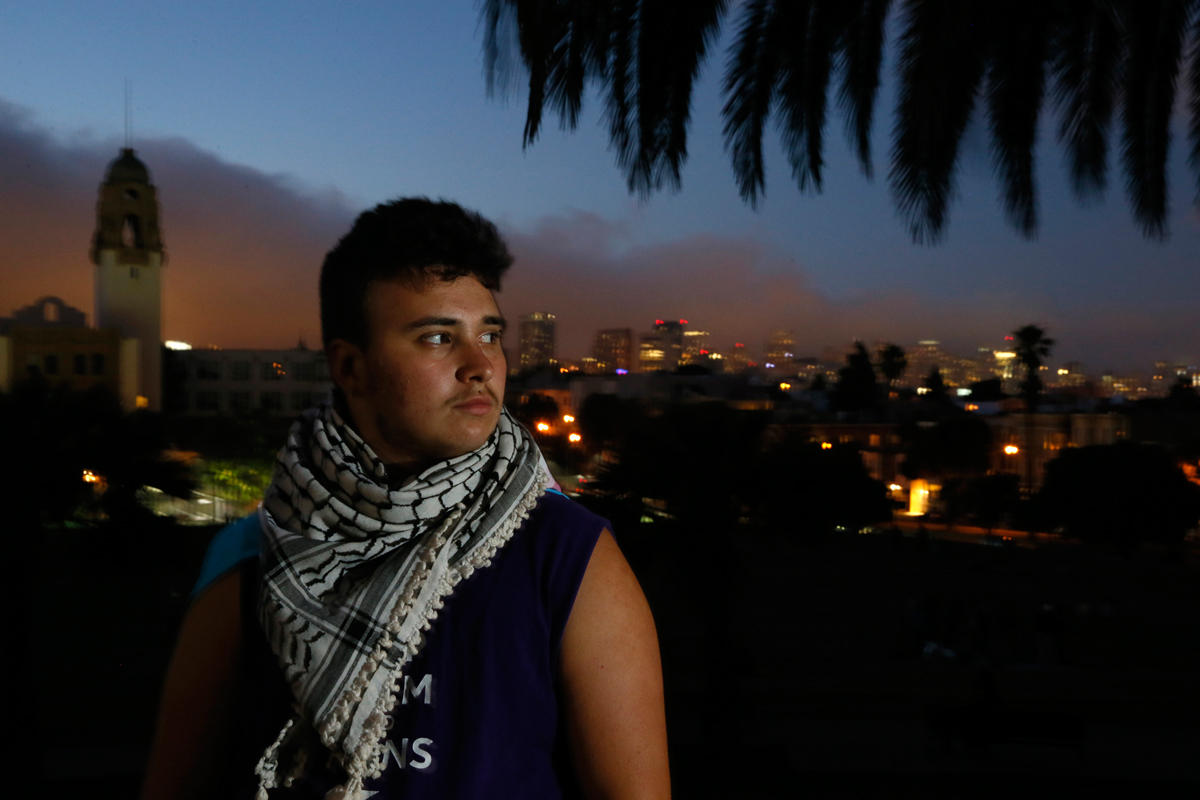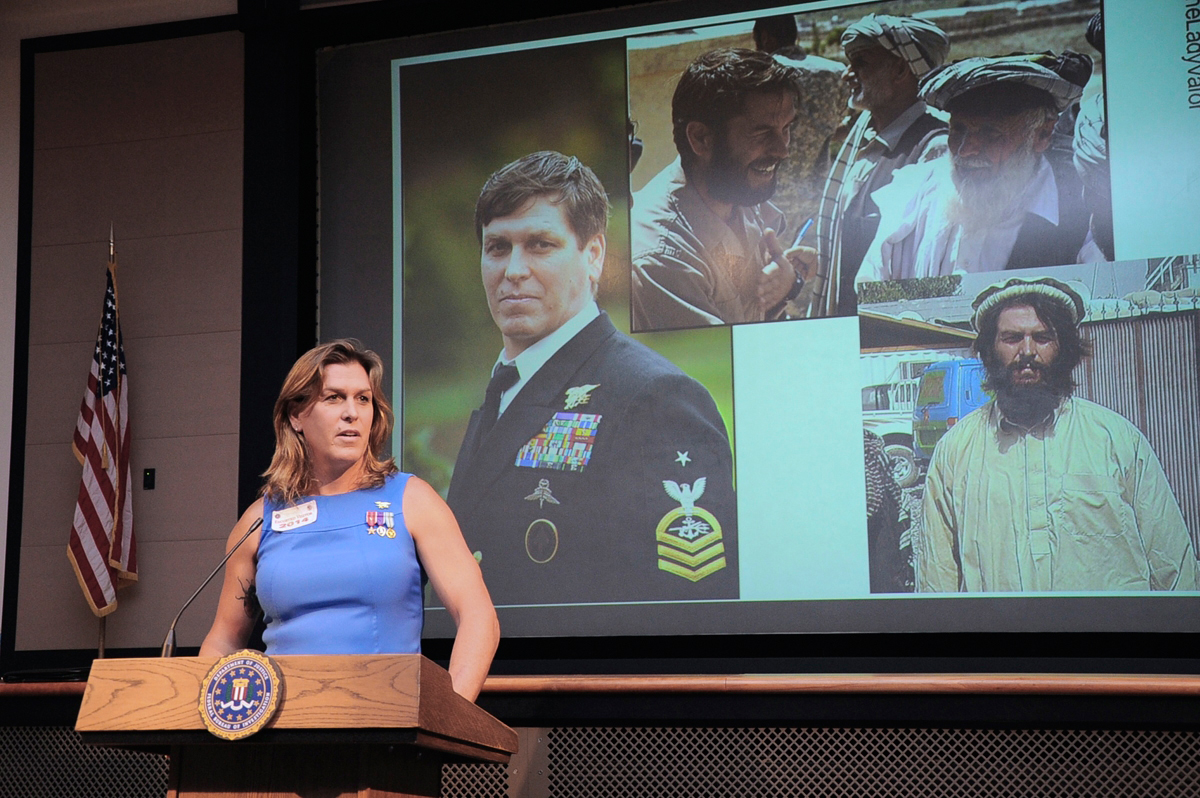Rivas told investigative reporter Cristina Costantini, his co-writer on the story, what he’d heard. It sounded familiar. Their colleague, Kristofer Ríos, recently told Costantini he had heard similar things about transgender detainees during his own immigration reporting. The three teamed up for a six-month investigation into the treatment of transgender people in Immigration and Customs Enforcement (ICE) detention centers. “Why Did the U.S. Lock Up These Women With Men?” was the headline. The story received an award for outstanding digital journalism from GLAAD (formerly the Gay & Lesbian Alliance Against Defamation), and, in June of 2015, ICE announced it would implement new guidelines for transgender detainees.
This past year has been a watershed for media coverage of transgender issues. In 2014, ESPN’s Grantland was sharply criticized for a piece that outed a transgender woman and may have contributed to her suicide, while talk show hosts Katie Couric and Piers Morgan were derided for insensitivity toward transgender guests on their respective programs.
In 2015, in contrast, ABC News produced a deeply researched, widely praised educational special in which Caitlyn Jenner came out as transgender. The Washington Post profiled a transgender woman who until recently had been out of work and homeless. In a story focused on a transgender man who is Muslim, the Los Angeles Times looked at conflicts between an individual’s religion and gender identity. And in a series of editorials The New York Times called for changes in the treatment of transgender people and invited the transgender community to tell its own stories on the Times website. In May, VIDA: Women in Literary Arts announced that it would include statistics on the number of articles written by LBTQI (lesbian, bisexual, transgender, queer, and intersex) writers and writers with disabilities in its next annual VIDA Count of bylines in literary publications.
This past year has been a watershed for media coverage of transgender issues
Transgender people—models, actors, musicians, authors, athletes, a former Army soldier serving time for espionage—have increasingly entered the public consciousness. With this increased visibility has come increased media coverage. Kris Hayashi, executive director of the Transgender Law Center in the San Francisco Bay Area, remembers how when he came out as transgender in the late 1990s there was very little to be found in the mainstream media about people like him. Now, he says, the transgender community is covered with a frequency that was “unimaginable” even three years ago.
Says Meredith Talusan, who in 2015 became BuzzFeed’s first openly transgender staff writer and covers transgender issues for the website, “Now, it’s actually possible to gain knowledge about trans issues from mainstream media sources. More of those sources have been willing to respect the ways in which trans people want to be addressed and portrayed, though there’s still a lot to be done.”
Despite this progress, the general population still knows relatively little about the transgender community. In a recent survey by the Human Rights Campaign (HRC), the largest LGBT civil rights organization in the U.S., only 22 percent of respondents said they knew a transgender person. This lack of knowledge, combined with the rapid rise in visibility for transgender people, has created unique challenges for newsrooms. Very few newsrooms have any openly transgender staffers.
How do journalists cover a community, which has been for so long maligned and voiceless, in ways that are considerate of that community’s needs as well as those of readers, some of whom need basic concepts explained? Most coverage to date has tended to focus on one transgender person’s pre-transition life and gender reassignment surgery, while rarely reporting on the wider transgender community. Stories have also often used terminology and pronouns that were objectionable to the transgender person. Reporters writing about the transgender community, for which violence and discrimination are major concerns, have to educate themselves about terminology and spend extra time building the rapport that can lead to nuanced coverage.
That was certainly the case with the Fusion investigation of transgender detainees in federal immigration facilities. Rivas and his Fusion colleagues needed to talk to transgender people, some of whom were victims of sexual assault, whose shaky immigration statuses landed them in ICE detention centers. Any of these three factors on its own could make a source wary of going public. In addition, the Fusion reporters needed people who were willing to tell their stories on camera. Apart from the reporting challenges, Rivas says, the team wondered how much readers who weren’t transgender would care about their subjects, members of a long-stigmatized community.
Before Rivas could meet with Barbra Perez, a transgender detainee featured in his Fusion piece, he met with Olga Tomchin, whose work at the Transgender Law Center focused on advocating for transgender people in immigration detention. The process of developing a relationship with a source or a source’s representative wasn’t different from any other story except for one thing: Tomchin asked if Rivas was going to film any of the transgender sources putting on makeup. Tomchin explained that this trope in coverage of transgender women is widely considered a superficial demonstration of femaleness to which cisgender women are rarely subjected. Rivas hadn’t intended to shoot that kind of footage, but learning that it was considered a cliché was “a lesson” for him. “We do try very hard to avoid putting our clients in situations where they feel exploited by media or that their story was manipulated,” says Jill Marcellus, senior communications manager at the Transgender Law Center.
More and more reporters are educating themselves on how to adequately cover transgender people. Couric and Morgan drew criticism for lines of questioning perceived as insensitive. Both Couric, who interviewed actress Laverne Cox and model Carmen Carrera, and Morgan, who interviewed writer Janet Mock, asked about their guests’ genitals, questions many transgender individuals and advocates regard as an invasion of privacy. “People ask trans people all the time, ‘So, have you had the surgery?’” says Dawn Ennis, a news editor at The Advocate, the oldest LGBT-interest magazine in the U.S., who is transgender. “People are curious about it because it’s so unusual, but it really is a violation of people’s privacy to ask those questions.”
Couric responded to the subsequent backlash by inviting Cox back on her ABC show to discuss what she had done wrong, saying she’d now have to hold up her show as an example of how not to report on transgender people. Morgan invited Mock back on his show for a contentious interview in which he demanded to know why he’d been “viciously abused” on social media by the transgender community after he said he had shown support for transgender people by promoting Mock’s book and calling her a woman.
Journalists are learning which lines of questioning transgender people might consider a violation of privacy
After the Fusion reporters won the trust of Tomchin, the Transgender Law Center representative, they had to win the trust of the women they wanted to profile. Johanna Vasquez’s story was probably the hardest to tell. After being brutally sexually assaulted in her native El Salvador, she fled to America. But she was beaten by her male cellmate in an ICE detention center and then locked in solitary confinement for seven months because guards didn’t know where else to put her. Rivas and Costantini say they met with her several times without a camera or even a notebook so they could establish the level of trust Vasquez needed to tell her story.
The Fusion team also needed data to show the scope of the problem. While a Government Accountability Office report stated that from October 2009 to May 2013, three of the 15 victims in cases of “substantiated allegation of sexual abuse” in ICE detention were transgender, ICE told the journalists it didn’t have a count of the total transgender detainee population.
Costantini consulted with the Williams Institute at the UCLA School of Law, a think tank that researches LGBT law, public policy, and demographics, and has produced transgender population estimates. The Williams Institute’s oft-cited number puts America’s transgender population at nearly 700,000, but this is largely based on surveys from two states: Massachusetts and California. Gender identity is rarely included on official forms from which this kind of data is usually drawn.

Johanna Vasquez, pictured here in a video, is a transgender woman who fled her native El Salvador after a brutal sexual assault. She met with Fusion reporters several times before she went on the record with her story
GLAAD has recommendations for how the media should cover transgender victims of violence, including referring to them by the name and pronouns consistent with how they identified at the time of the incident, and refraining from salacious and unnecessary details about the victim’s appearance or gender identity. “In major cities, we’ve seen a lot of growth in terms of media understanding and ability to think beyond just what the plain old police report says,” according to The Advocate’s Ennis.
A big uptick in stories about transgender people occurred after April 2015, when Caitlyn Jenner came out as transgender in a two-hour special on ABC’s “20/20.” ABC News producer Sean Dooley says the show was a unique opportunity not just to tell Jenner’s story, but also to educate a largely uninformed television audience, some of whom wouldn’t normally watch a special about a transgender person but watched this one because of Jenner’s fame as an Olympic athlete or reality show star.
Dooley says ABC News spoke with several advocacy groups and experts, including GLAAD and the National Center for Transgender Equality, to prepare for the special. Susan Stryker, an associate professor of gender and women’s studies at the University of Arizona and director of the school’s Institute for LGBT Studies, says she was on the phone with producers three times a week for about a month.
That effort was evident when the special aired. Host Diane Sawyer didn’t just use Jenner’s chosen pronoun, she also noted that she was doing so and explained why. Allowing transgender people to decide which pronouns should be used in referring to them is an important issue for the transgender community. This was especially important as, at the time, Jenner’s pronoun preference was male, which could potentially lead people to think it’s acceptable to refer to all transgender women with male pronouns. And Sawyer didn’t just ask which surgical steps Jenner might take in her transition, she also noted that it was Jenner’s choice to discuss this, and that, generally, asking a transgender person about their genitals is inappropriate.
The special was largely well received—and watched by about 17 million people that night, more than twice as many people as usually watch the network in that time slot. Many transgender advocates, worried that a profile of a reality show star on mainstream television would be sensationalist and exploitative, applauded the program.

Sara Simone hugs a friend who provided shelter when she was homeless
As a contrast to Jenner’s story, Washington Post feature writer Monica Hesse profiled Sara Simone, a transgender woman in her 50s a few years into her transition who was, until very recently, unemployed and homeless.
According to the National Transgender Discrimination survey, carried out in 2011 by the National Center for Transgender Equality and the National Gay and Lesbian Task Force (now known as the National LGBTQ Task Force), 15 percent of transgender people and gender-nonconforming people surveyed said they earned less than $10,000 annually, compared with just 4 percent of the general population. Transgender people are also twice as likely as the general population to be unemployed, and one in five said they had experienced homelessness at some point in their lives because of their gender identity.
Simone was willing to share details about her financial troubles for the profile. She was not willing to share her birth name, however.
While Hesse and her editor, Post senior editor at large Ann Gerhart, needed to know Simone’s birth name for fact-checking purposes—verifying that she served in the armed forces, for instance—they saw no need to include it in the story. “One of the ways we looked at it was, this is her legal name now,” Hesse says. “When we write about women who have taken on their husband’s names and those are their legal names, do we then make sure to include their maiden names? No, we don’t do that.”
Similarly, they didn’t see a need to dwell on Simone’s life before her transition. This was a story about Simone’s life now. At the same time, Gerhart says, Simone had lived as a man for five decades: “Journalistically, I had questions about how she dealt with that. What are the ways you can reconcile the person who you had been and who you are relieved you aren’t anymore, and integrate that into your experience now?” A chance encounter at Simone’s workplace gave the story insight into those questions.
Simone worked at a nonprofit that helped homeless veterans. While meeting with one of those veterans, she noticed that he’d been stationed in the same place as Simone around the same time. Simone faced a decision. She could tell him about her own service, possibly helping her bond with the client. But that would mean revealing that she served under another name, opening her up to harassment for being transgender. Fear of harassment and violence from people who discover Simone is transgender is a recurring theme in the story. In the end, Simone didn’t reveal her military service to the veteran.
A focus on telling individual “coming out” stories is a missed opportunity to provide a broader picture of the transgender community
Simone’s fears are well grounded. Transgender women, especially women of color, are often targets of violence. A 2015 report from the HRC and the Trans People of Color Coalition, which advocates for transgender people of color, estimates that transgender women are 4.3 times more likely than cisgender women to be the victim of a homicide, and half of all transgender people will be sexually assaulted in their lifetimes. As of this past November, at least 21 transgender people—a majority of whom were transgender women of color—had been murdered in 2015.
“It’s a real clear crisis that’s happening, but it’s not a new crisis,” says the Transgender Law Center’s Kris Hayashi. While some outlets have covered this issue, he says, it hasn’t gotten anywhere near the attention that Jenner has. Stryker, the University of Arizona professor, says it’s important for the media to remember that the transgender community is diverse, and not everyone in it will have the same experience. The progress that has been made may be beneficial to some, mostly white people of means, but not necessarily all, especially transgender women of color or people living in poverty.
Simone’s comments on social media are also quoted throughout the Post story, something Hesse and Gerhart say was crucial since it allowed them to let Simone talk about herself and her experience unprompted. In a video post in which she describes an abusive past relationship, Simone says, “This man tried to destroy me, but he didn’t destroy me.” “I am very, very lovable,” she writes in another update. “I am not a loser. I am lovable.”
Simone friended Hesse on Facebook, which gave Hesse unexpected insight into her own reporting process. In the beginning, Simone would often say things on Facebook that she apparently didn’t yet feel comfortable saying to Hesse. “Every time I would go home, she would post on Facebook an analysis of how she thought I had done that day,” Hesse recalls. “What questions I had asked that she thought were stupid, or what she was afraid I wasn’t getting. It was really interesting to see your reporting reviewed in real time that way.”
It also gave Hesse a measure of how much her subject grew to trust her over the week they spent together. As time went on, the things Simone said on Facebook began to match what she told Hesse. To help foster a trusting relationship with Simone, Hesse had sent her a few articles she had written, including a profile of an agender (someone who doesn’t identify as male or female) teenager. She didn’t take any notes on the first day. By the end of the week Hesse spent following Simone to work, to her home, and even going out with friends, Simone trusted Hesse enough that she let Hesse meet her brother, someone she’d initially been reluctant to include in the story. Hesse thought the brother was necessary to the story because she felt she needed another scene of Simone interacting with someone who knew her well, and who was the closest family member Simone had at the time.

Alex Bergeron struggles to reconcile being transgender and Muslim, an issue explored in a Los Angeles Times story
Therolf found an expert on transgender issues and Islam in Emory University professor Scott Siraj al-Haqq Kugle, who has written multiple books about the subject of LGBT issues and Islam. “He helped me to realize how lonely it can be for folks trying to find their way and just how very nascent this movement [of LGBT Muslims] still is,” Therolf says. “And he helped me understand the theological underpinnings for the work that is just beginning.”
Therolf wrote in his story that in America “mosques tend to be conservative, and visits to the local imam or mosque committee chairman usually draw stern rebukes for LGBTQ Muslims.”
Therolf was unsure whether he made the right call when it came to the pronouns he used for Bergeron. Bergeron’s preferred pronoun is “they,” because, as Therolf’s article explains, Bergeron sees gender identity as a spectrum, rather than a binary. People who prefer gender-neutral singular pronouns, then, must either use invented terms like “ze” or the plural pronoun “they” as a singular. Both options are potentially confusing to reporters and readers who aren’t used to seeing them.
Therolf got permission from the copy desk to use “they” and wrote a draft of the story, but ultimately he found it was too confusing to use a plural pronoun for an individual. “It is technically ungrammatical and it can be quite cumbersome and distracting for readers in a news story,” Therolf says. “I don’t know if we made the right call by reverting back to ‘he,’ but I will point out that Alex himself uses ‘he’ pronouns most of his day and so do the people around him.” The Transgender Law Center, in its “Trans Youth” guide to reporting on transgender and gender non-conforming young people, notes that many in that community use “they” as a pronoun.
Henry Fuhrmann, an assistant managing editor who oversees the Los Angeles Times copy desk, says Therolf’s decision to use “he” instead of “they” this time should not indicate that’s what the paper will do if the issue comes up again. “We’ll consider then what we think will work best for the story and its intended audience,” Fuhrmann says. “We’ll need to balance sensitivity to a subject against the risk of confusing readers.” Therolf says he thinks that as the concept of using “they” as a singular gender-neutral pronoun becomes more prevalent, it’ll be less confusing to readers.
In just the few months since Therolf’s story was published, both The New York Times and The Washington Post have used new gender-neutral terms. At the beginning of December, Post copy editor Bill Walsh sent out a memo stating that “they” could be used as a pronoun for people who did not identify as male or female. In late November, The New York Times used “Mx.” as an honorific—to much notice.

Kristin Beck, a transgender former Navy SEAL, shares images from her past during a talk at an FBI office in Clarksburg, West Virginia
More than 20 people—from developers to designers to photographers to editorial writers—helped get the series off the ground. Londoño had written about a transgender person before, but some members of the team had not. “It was an education for a lot of us,” Londoño says. Much of that education took place in the early stages of the project, when the team spent a lot of time discussing what was sensitive and what wasn’t, not just in the writing, but also in photography and design choices. This, says Transgender Law Center’s Marcellus, is an important but often overlooked component in coverage. A reporter can be extremely knowledgeable about the correct terminology, but an article can be completely undermined if it’s accompanied by an insensitive photo caption or headline.
For the series, Londoño says advocacy groups were helpful in identifying issues the transgender community faced and providing necessary historical context and case law. There’s also a significant contribution from transgender people, in their own words and images. “We thought it would be very important to find a way to let transgender people tell their own stories and be their own advocates,” Londoño says.
Stories transgender people posted on The New York Times site about the difficulties of serving in the military influenced an editorial on the subject
To do this, the paper created a “storywall” for the series, allowing readers to submit their own experiences in text, photo, or video form, or a combination of all three. Brynn Tannehill’s video starts with the former Navy pilot describing when she realized she wanted to fly planes, and how she ultimately had to make a choice between her military career and coming out as transgender. Jesse writes about how he came out as transgender and began his transition while working as an educator in Louisiana—and how his students and co-workers have been largely supportive. Scott writes about being fired from his job at a software company in the San Francisco Bay Area after co-workers found out he was a transgender man. Katherine Bradford writes about being transgender and a parent, and sometimes explaining this to her children’s new friends or their parents.
Londoño wasn’t sure how eager transgender people would be to share their stories so publicly. He says the paper hoped for 50 stories by the end of the year. It got 40 by the end of the first day.
“One of the things that struck me when we started getting submissions was a lot of them were from veterans and people who talked about how hard it had been to wrestle with their gender identity and their career in the military,” Londoño says. “A lot of those people were discharged or saw no option but to leave the service. Those voices, I think, were very valuable for me and for us as we set out to make the case for a new policy in the military that allowed open transgender service.”
That editorial was published in June, and Londoño, who worked on the article with the LBGT organization Service Members, Partners, Allies for Respect and Tolerance for All, which specializes in military issues, says it’s the one of which he’s most proud. In July, the U.S. Department of Defense announced that it was working on new policies that would allow transgender people to serve openly in the military.
Reporting on the transgender community has come a long way in a very short time, but transgender individuals and advocates say there is still much work to be done. Among other things, BuzzFeed’s Talusan would like to see more stories about transgender people that aren’t just about their gender identity, stories where being transgender is not a subject’s defining characteristic.
“I would just like to see stories about what trans people are doing with their lives and in many ways not focusing on their transgender-ness unless it’s relevant somehow,” says the University of Arizona’s Stryker. “I think we’re just getting to that point.”



